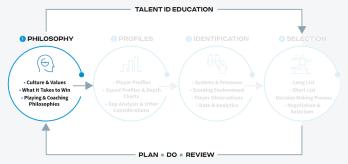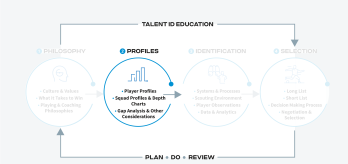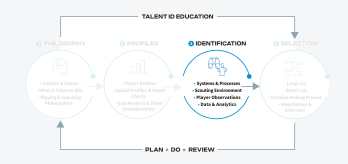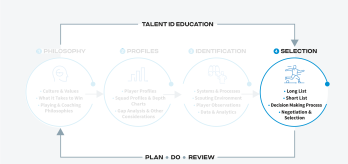Talent identification is essential for building a successful football programme, serving as the foundation for key areas such as talent development. Extending from Modules 1, 2, 3, and 4, shaped by its philosophy, profiles, identification, and selection, respectively, an organisation should have a clear, comprehensive, and structured talent identification system in place.
This fifth and final module highlights the two ‘constants’ (i.e., talent identification operations that are occurring continuously over a period of time), including the plan-do-review process and talent identification education. These are continual processes that underpin the entire talent identification system, ensuring its effective and efficient implementation. The plan-do-review process establishes a structured approach for assessing, refining, and enhancing talent identification processes. Talent identification education ensures key stakeholders of a football organisation are regularly upskilled and equipped with the latest knowledge, in order to foster a culture of informed decision-making, continuous improvement, and long-term success.
Why is this dimension important?
The plan-do-review process and talent identification education make-up the constants dimension of the talent identification model. For a football organisation to build and maintain a reliable talent identification system, the plan-do-review process and talent identification education are crucial. They play a critical role in the continuous growth and development of staff, stakeholders, and the organisational structures involved.
A plan-do-review process allows football organisations to allocate suitable time to plan, execute, and review any specific talent identification activity leading to constant improvements. Reviewing the processes and learning from good practice or mistakes during the different phases (i.e., plan and do) is a vital part of both development and learning, ultimately enhancing talent identification processes and the overall system in the long-term.
In order to improve knowledge, expertise, and performance, talent identification education should be made available to all those involved in the pathway. This includes all stakeholders that make selection decisions (e.g., technical directors, senior management) or are a part of the identification process (e.g., scouts, youth team coaches). Education courses should develop learners understanding and application of the principles and practices of modern talent identification within long term player development. The overarching talent identification system should set out standards for the education and development of talent identification staff at all levels, and guide the licensing of scouting and talent identification staff that are aligned to the organisation’s goals.
How do you achieve success?
Implement a ‘plan-do-review’ process
The focus of a ‘plan-do-review’ process is to create a structured and continuous cycle for strategic improvement. By ensuring all stakeholders are involved in planning, delivering, and reviewing, organisations can enhance efficiency and support long-term success. Allocating time and resources across all three phases fosters consistency, adaptability, and more efficient decision-making processes.
-
How do you currently plan?
-
What is the most effective and efficient way of carrying out the plan?
-
Is everyone who is involved in the delivery of talent identification taking part in the planning and reviewing process?
-
Do you have a formal review process, which involves reflection, feedback, and feedforward?
-
In order to have an effective strategy and consistently develop talent identification processes, it is important to have a regular planning and reviewing processes in place (e.g., weekly, monthly, quarterly, bi-annually, annually).
-
Note how time and resources are often allocated towards ‘doing’, and reflect on how time and resources could be placed more equitably on all three of the plan-do-review processes.
-
By regularly scheduling time for reflection and feedback, football organisations can support continuous learning, refine scouting accuracy, and create a more effective system to improve talent identification.
-
MODULE 5 │ THE PLAN-DO-REVIEW PROCESS: This template supports effective decision-making, accountability, and continuous improvement in talent identification practices.
-
MODULE 5 │ THE REVIEW PROCESS IN TALENT ID: This resource provides a thorough overview of how to review an organisation’s talent identification processes.
-
Scotland’s Andy Gould - Understanding the context of your strategy in order to prioritise time and resource: Within this article, you can learn more about how you can plan and implement effective strategies within your football organisation.
Implement talent identification education
The focus of talent identification education is to equip staff and stakeholders within the organisation with the knowledge and skills needed to effectively carry out talent identification activities. By providing formal training and tailored education programmes, organisations can ensure a consistent and informed approach to talent identification, which is aligned to their philosophy, profiles, identification, and selection goals.
-
How do you upskill your staff who are involved in the talent identification process?
-
Are there any formal talent identification qualifications available (internal or external) for relevant members of staff?
-
Are there specific talent identification education programmes for the different areas of talent identification (e.g., identification systems and processes, scouting environments, player observations, data and analytics)?
-
Are you using and embedding scientific evidence related or relevant to talent identification to help inform your education?
-
Think about how this aligns to the overarching education framework or process to upskill staff/stakeholders within the football organisation.
-
Suggest how talent identification education could be embedded into other education courses within the football organisation (e.g., coaching development workshops/sessions).
-
Consider talent identification as a standalone education course/provision to upskill stakeholders within the football organisation.
-
Invest in technical staff with a high level of expertise who can lead and be responsible for talent identification education and coach development within the football organisation (e.g., course delivery, mentoring opportunities).
-
The role of the talent identification manager: Within this interview you can learn about the role of the talent identification manager, from the perspectives of working in a professional football club and in a national football association setting.
-
Finland and England: Contrasting approaches to educating coaches about talent identification: No country or region is the same. This presentation, given by coach education and talent identification experts, reveals the differing approaches to talent identification education adopted by the English and Finnish football associations.
Reflection checklist
The following reflection checklist will help a football organisation critically evaluate and refine the ‘plan-do-review’ process and ‘talent identification education’ (i.e., the constants dimension), strengthening the overall talent identification system:
Summary
-
To ensure an effective ‘plan-do-review’ process, football organisations must equally invest time into each phase, building a comprehensive process.
-
Emphasising the review process to assess outcomes, and encouraging open and constructive discussion to learn from mistakes, will help enhance the refinement and development of current approaches.
-
Delivering continuous talent identification education through existing education provisions or stand-alone courses will ensure an informed and effective approach to talent identification.
-
Leverage good practice examples, tools, and resources provided within this guide to implement and improve the constants (i.e., ‘plan-do-review’ process and ‘talent identification education’) for long-term success.


















.variant64x64.png)
.variant348x164.png)